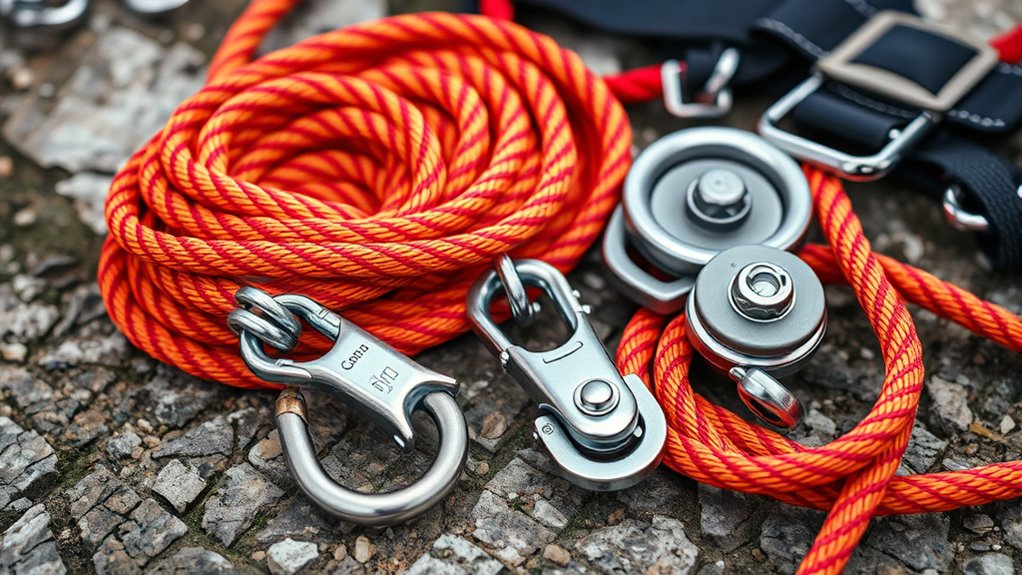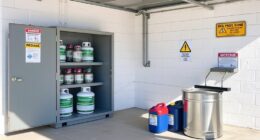To get started with rope rescue equipment, you’ll need gear like ropes, harnesses, carabiners, and knots such as the figure-eight and bowline. Always verify your harness fits well and is in good condition, and check that all connection points are secure before starting. Proper knot techniques and dynamic load management are key to safety. Mastering these basics helps you prepare for more advanced rescue skills—learn more to become confident in every rescue situation.
Key Takeaways
- Essential rescue equipment includes ropes, harnesses, carabiners, pulleys, and knots for safe high-angle rescues.
- Proper knot tying techniques like figure-eight and bowline ensure secure anchor points and harness connections.
- Managing dynamic loads prevents equipment failure by understanding load distribution and equipment limits.
- Rescue harnesses must be correctly fitted, inspected, and positioned to distribute forces and maintain stability.
- Regular checks of connection points and secure knots are vital for overall system safety during rescues.

Rope rescue equipment is indispensable for safely performing high-angle rescues and ensuring both rescuers and victims stay protected. When you’re involved in a rescue operation, knowing how to effectively use the right gear can make the difference between a successful rescue and a dangerous situation. One of the key skills you’ll need is mastering knot tying techniques. These are fundamental to creating secure anchor points, harnesses, and connection points that won’t slip or fail under load. Whether you’re tying a figure-eight knot, a bowline, or a double fisherman’s knot, each plays a crucial role in ensuring your setup remains stable throughout the rescue. Proper knot tying not only provides strength but also allows for quick adjustments if circumstances change. Practice these techniques regularly because, during an actual rescue, hesitation or mistakes can compromise safety. Additionally, understanding the importance of dynamic load management can help prevent equipment failure under varying forces during rescue operations.
Alongside knot tying, rescue harness safety stands out as a critical component. Your harness is your primary interface with the rope system, so ensuring it’s correctly fitted and in good condition is non-negotiable. A well-maintained harness distributes forces evenly across your body, reducing injury risk during a fall or a high-angle descent. Always double-check the harness’s buckles, straps, and stitching before starting any rescue. Adjust the fit so that the harness is snug but comfortable, with no loose straps that could slip or cause discomfort. When attaching yourself to the rope system, use secure and properly tied knots, and ensure all connection points are locked and double-checked. Harness safety also involves understanding how to properly position yourself during the rescue to maintain balance and stability, especially when working at heights or in challenging environments.
Frequently Asked Questions
What Are the Latest Innovations in Rope Rescue Gear?
You’ll find that the latest innovations in rope rescue gear include smart harnesses and lightweight carabiners. Smart harnesses now feature integrated sensors that monitor load and safety status, providing real-time data to responders. Lightweight carabiners are made from advanced materials like aluminum composites, reducing weight without sacrificing strength. These innovations enhance safety, mobility, and efficiency, making rescue operations faster and more effective. Staying updated on these advancements guarantees you’re well-equipped for any rescue scenario.
How Do Weather Conditions Affect Rescue Equipment Performance?
Weather impact markedly affects your rescue equipment’s performance. Extreme cold can make ropes brittle, reducing durability and increasing the risk of failure. Wet or humid conditions can cause gear to slip or corrode, compromising safety. High temperatures may weaken certain materials. Always check weather forecasts and inspect your gear before use, ensuring equipment durability isn’t compromised. Proper maintenance and choosing weather-resistant gear help you stay safe during challenging conditions.
What Maintenance Is Required for Prolonged Equipment Lifespan?
To guarantee your rescue equipment lasts, you need to follow regular inspection routines and proper storage practices. Check for signs of wear, fraying, or damage after each use, and replace any compromised gear. Store equipment in a cool, dry place away from direct sunlight and chemicals. This prevents degradation and extends its lifespan. Consistent maintenance keeps your gear reliable and ready for critical rescue operations.
Are There Specific Certifications for Advanced Rescue Tools?
Did you know that over 60% of rescue teams seek advanced certifications? You should pursue certifications for your rescue tools to make certain you’re meeting certification standards and maintaining equipment compliance. These specialized qualifications verify your skills and knowledge, helping you operate advanced rescue tools safely and effectively. Staying certified guarantees you’re up-to-date with industry best practices, which improves safety and performance during critical rescue operations.
How Do Rescue Teams Select Equipment for Different Scenarios?
You select equipment for different scenarios by conducting thorough risk assessments and following training protocols. First, evaluate the hazards and environment to determine the appropriate tools. Then, choose gear that matches the specific rescue needs, ensuring compatibility and safety. Your training helps you understand how each piece functions in various situations, enabling you to make quick, informed decisions that maximize rescue efficiency and safety for both victims and team members.
Conclusion
Mastering rope rescue equipment is like wielding Excalibur—your tools become extensions of your skill and courage. When you understand their purpose and proper use, you’re prepared to face challenging scenarios with confidence and precision. Just as King Arthur’s sword symbolizes strength and responsibility, your equipment embodies the essential role you play in saving lives. With knowledge and practice, you’ll be ready to rise to any challenge, turning potential chaos into controlled, safe rescues.









